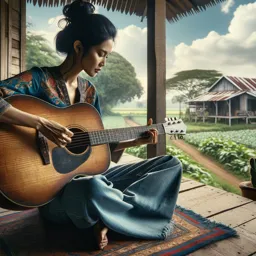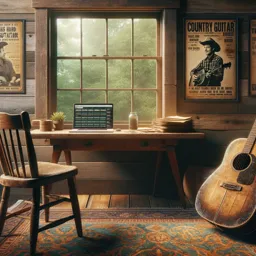Introduction:
Blues guitar has been a foundational influence on countless genres of music, from rock and roll to jazz, and its roots can be traced back to the African American communities in the early 20th century. The development of blues guitar is a rich story of innovation, emotion, and expression. This article explores the evolution of blues guitar, from its origins with pioneers like Robert Johnson to the modern-day legends who continue to shape its sound.
The Early Years: Delta Blues and Acoustic Origins
The birth of blues guitar is often associated with the Mississippi Delta region in the early 1900s, where guitarists began blending African rhythms with European harmonic structures.
- Robert Johnson: Widely considered one of the most important figures in early blues guitar, Robert Johnson’s haunting slide guitar work and storytelling influenced generations of musicians. His songs, such as “Cross Road Blues” and “Sweet Home Chicago”, remain iconic.
- Son House and Charley Patton: Alongside Robert Johnson, artists like Son House and Charley Patton helped define the Delta Blues style. Their raw, emotional guitar playing, often accompanied by slide guitar techniques, laid the foundation for the blues’ signature sound.
Chicago Blues: The Electric Revolution
As blues musicians migrated to urban centers like Chicago in the mid-20th century, the genre evolved from acoustic to electric. This transition brought about the Chicago Blues, which featured amplified instruments, bands, and a more polished sound.
- Muddy Waters: Muddy Waters is often credited with transforming the blues into an electric genre. His electrified guitar and powerful vocals brought blues to a broader audience. Songs like “Hoochie Coochie Man”and “I’m Ready” showcased his influence on blues and the budding rock and roll movement.
- Howlin’ Wolf and Willie Dixon: Alongside Waters, guitarists like Howlin’ Wolf and Willie Dixon contributed to the development of Chicago blues. Their collaboration and songwriting, along with the electrification of the guitar, made blues accessible to radio audiences and influenced future guitarists like Eric Clapton and Keith Richards.
The British Invasion and Blues Revival
In the 1960s, British musicians fell in love with American blues records, leading to a revival of blues guitar that brought the genre to global audiences.
- Eric Clapton: As a founding member of The Yardbirds and Cream, Clapton became known for his electric blues guitar style, heavily inspired by Delta and Chicago blues legends. His ability to merge blues with rock led to hits like “Crossroads” and “Sunshine of Your Love”.
- The Rolling Stones and Led Zeppelin: British bands like The Rolling Stones and Led Zeppelin brought blues guitar to stadiums worldwide. Songs like “You Shook Me” by Led Zeppelin and “Little Red Rooster” by The Rolling Stones paid homage to their blues roots while expanding the genre into hard rock territory.
The Modern Blues Guitar Legends
While the blues is often associated with its early pioneers, the genre has continued to evolve, with modern-day legends pushing the boundaries of blues guitar.
- Stevie Ray Vaughan: Stevie Ray Vaughan revitalized blues guitar in the 1980s with his searing solos and virtuosity. Songs like “Pride and Joy” and “Texas Flood” reintroduced blues guitar to mainstream rock audiences.
- Joe Bonamassa: A modern blues guitar hero, Joe Bonamassa has continued to carry the torch for the blues, combining traditional techniques with modern production. His mastery of both electric and acoustic blues guitar has made him a leading figure in today’s blues scene.
Conclusion:
The history of blues guitar is a testament to the power of innovation, emotion, and the human experience. From the acoustic origins of the Mississippi Delta to the electric sounds of Chicago and beyond, blues guitar continues to influence countless musicians. The genre’s legacy lives on, proving that blues guitar is not just a sound but a timeless expression of storytelling and emotion.


























